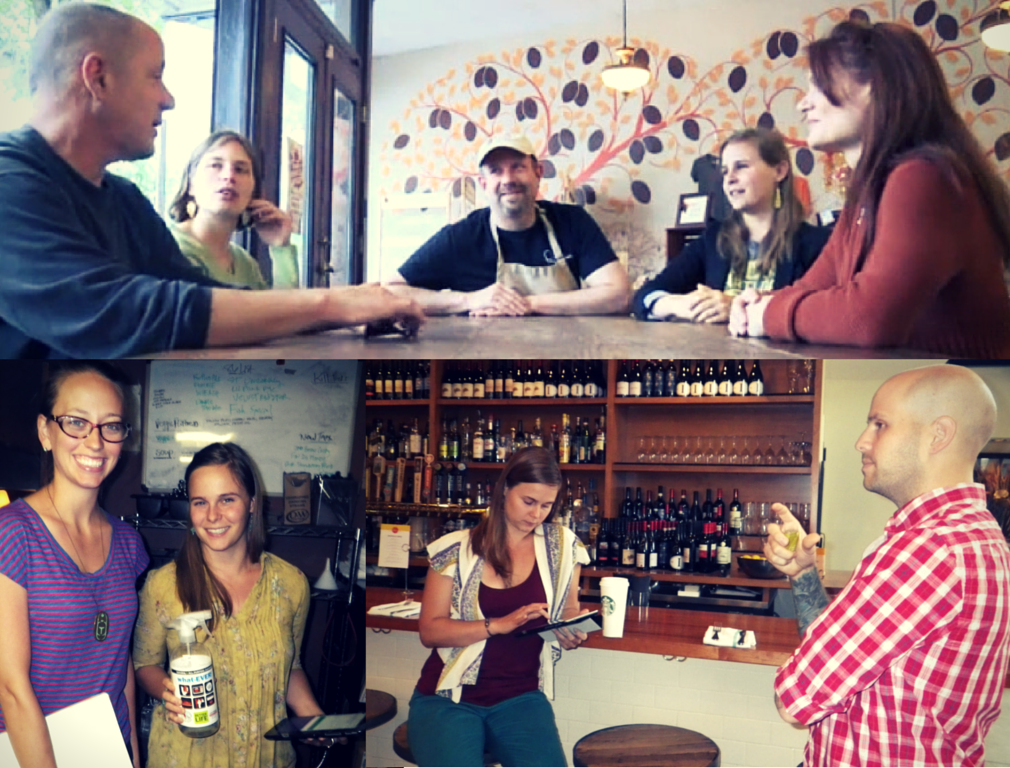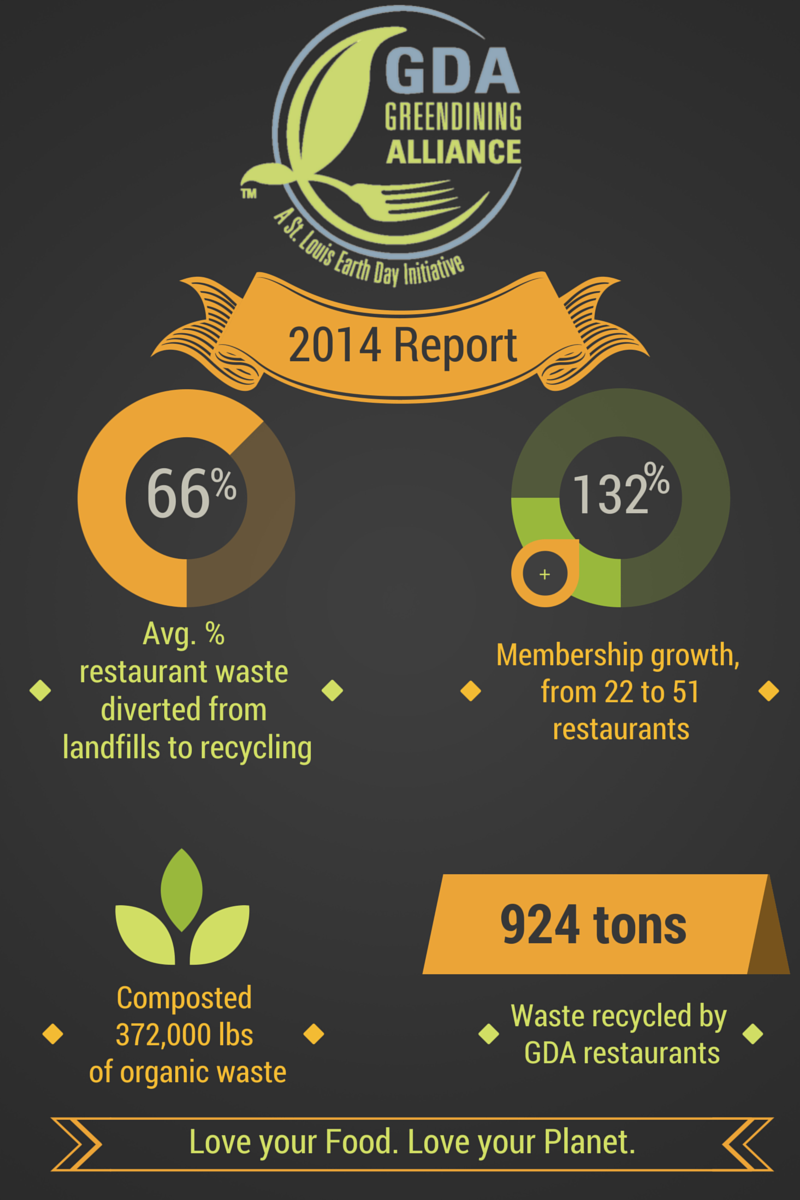Written and published October 2015 by Olivia Engel, Green Dining Alliance Program Coordinator
St. Louis has an expanding, evolving, and – I would say – fantastic food scene. Concurrently, the sustainability movement continues to gain momentum and urgency. This phenomena can be found all around the country, but in our own small-town-in-a-big-city, we have something uniquely awesome: the Green Dining Alliance. I am proud and gratified to have been a part of raising this program up to be the solid contender for change and engagement that it is today.

While running Green Dining Alliance, I set goals and collaborated with local industry leaders and community champions. That’s what makes the GDA unique in St. Louis – and nationally – as an in-person sustainability certification program.
After working at seven different St. Louis County and City restaurants over the course of almost a decade, I felt defeated by the massiveness of the industries and culture behind food service. I learned again and again that restaurant management work so much and so hard that they don’t feel that they have time to learn (or, in many cases, care) about sustainable practices, let alone implement them. I felt like there was hardly anyone ‘doing the right thing’ in restaurants, and that things would never change.
Having had the opportunity to work here for two years, I don’t feel that way anymore.
Green Dining Alliance is a small program. It’s budget is laughable. It hardly gets any press. It’s person-power is limited to one full-time GDA staff with some support from its parent organization, St. Louis Earth Day – the folks behind the massive, 40,000+ attended Earth Day Festival in Forest Park.
Despite the challenges, this tiny non-profit project has turned into a powerful idea with tangible results. It’s a program that personally walks into a St. Louis-owned restaurant, shakes hands with the management, and works alongside them to help them decrease their footprint and achieve goals through certification. It also calls on the St. Louis public to direct their dining dollars toward locally-owned restaurants that have committed to environmentally-responsible business practices.
A seemingly simple idea, but food service is tied up in almost every industry you could imagine, and all of them have intense environmental impacts. Usually, our minds jump to food – and since we know now that agriculture (animal agriculture in particular) is considered by many to be the largest global contributor to climate change and pollution, it requires thorough consideration and action.

Impacts of food are an important part of the GDA – but there’s a lot more to restaurants than their menus.
But restaurants need more than food to keep themselves running. GDA certification covers every major category of sustainability to maintain integrity:
- waste reduction and diversion,
- food and beverage sourcing,
- water and energy conservation,
- chemical usage,
- and social sustainability via education, awareness, and innovation.
On top of that, staff buy-in and compliance is crucial, or any money or time spent on sustainability simply (and also literally) goes down the drain.
The culture behind food service is possibly the largest obstacle. It takes an agile, relatable program to ensure a local restaurant owner is benefiting from ‘going green’ instead of hurting their bottom line – instead, convincing them of the triple bottom line that powers all economic systems, and offering to guide them to a balanced approach for their business.
The GDA is now that program. When I was hired in summer of 2013 to launch the program beyond its pilot stage, the GDA had 9 certified restaurants, all of which were early adopters of eco-friendly business practices and didn’t need to make significant changes to qualify. We now have 67 restaurants certified, with another 12 waiting in line. To the best of my ability (and within the frustrating limitations of market availability), I’ve connected these restaurants to local farmers and distributors, cleaning products that are non-toxic to their staff and customers, and incentives to ease the financial burden of retro-fitting smarter technology.
In a Midwestern city where it’s still a struggle to convince people just to recycle, where Styrofoam runs amok, and where a lot of people seem to think that practicing an environmentally-sound business or lifestyle brands you a “hippie” (whatever that means), GDA restaurants have made St. Louis history with a Green Dining District in Maplewood and enough valuable material diverted from landfills to recycling/composting centers to fill about 13 three-story American houses in 2014 alone. We’ve corralled dozens of St. Louisans to our Dine Outs to support local, green establishments with their dining dollars.

Here’s how large of an impact GDA restaurants make together. The GDA is currently the only organization tracking and quantifying the waste footprint of St. Louis restaurants.
These results have attracted more restaurants and more funding. The program stands on its own feet, mature and ready to truly take off. I’ve passed the torch to the charming and dedicated Jenn DeRose, and I feel confident that we will see the program flourish even further under her command.
A Bright Future Lies Ahead
St. Louis is my hometown. I grew up in its ‘burb havens, moved away for several years for school and travel, and returned five years ago to put down roots in the city. I don’t think folks realize how much potential is here – not just for start-ups, or an IKEA, or real estate. Now more than ever, St. Louis is poised to be a great sustainable city, leading the rest of the country. And we’ve already started: with food.
That might sound ‘pie in the sky’ to you, but consider the following: the GDA is hard at work building a sustainable dining culture as an alternative to the wasteful, toxic status quo. We’ve got some of the nation’s most diverse farm lands in Missouri, despite the rows and rows of corn you’ll see east of the river. Our local foodshed is exciting, and it’s expanding. And our city’s heat bubble, crumbling infrastructure, food deserts, unemployment, and ‘blighted’ areas with abandoned spaces can all be solved with the same course of action: ‘green collar’ workers retrofitting efficient equipment and creating living, edible spaces in the place of asphalt and dilapidated lots.
If we can be innovative and resourceful – and if our public funding can finally go toward the public good – our city’s neglected and forgotten spaces can become farms, greenways, and lush public parks filled with wild food. They’ll cool our city, create lasting jobs for working-class people, and feed our ever-growing demand for locavore cuisine.
Imagine: All your favorite restaurants could be filled with fresh, nutritious food that is so local, it’s delivered by bike and grown by your neighbors. Every single restaurant would recycle, compost, get rid of disposables, and conserve water and energy. Because it’s the right thing to do and because it saves money and keeps our shared environment healthy for everyone. This vision can be made a reality with nonprofits, entrepreneurs, and citizens coming together.
I look forward to seeing what the GDA can accomplish within the framework of our growing, changing sustainability movement. In the mean time, I’ll continue to offer supplemental help to them as I roll up my sleeves to finish my book, and then dive into a new venture that will supplement the vision I described above.
I want to thank all of the restaurant owners and staff, community leaders, and non- and for-profit partners for making this idea into a reality with us. It truly is an alliance and can’t operate without the people power and passion that champions drive forward. Credit is also due to our supporters, particularly the St. Louis-Jefferson Solid Waste Management District (SWMD), which funds urgently-needed local programs like this one every day.
Cheers,
Olivia


